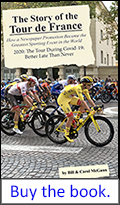

The Perfect Storm–The Story of Bicycle Retailing
Part 3: Juvenile Bikes Move to the Mass Market and the Internet
by John Neugent
Back to list of tech articles | Commentary articles | Perfect Storm part 1 | Perfect Storm Part 2
The late John Neugent probably knew more about bicycle wheels than anyone else. Maybe more about bikes as well. He spent his life in the bike business, at every level. He owned Neugent Cycling, a firm devoted to delivering world-class equipment at the lowest possible price. —Chairman Bill

John Neugent

Bill & Carol McGann's book The Story of the Tour de France, 2020: The Tour During Covid-19, Better Late Than Never is available as an audiobook here. For the Kindle eBook version, just click on the Amazon link on the right.
John Neugent writes:
The Perfect Storm—The Story Of Bicycle Retailing
The Perfect Storm was a book and a movie that describes the story of the Andrea Gail, a fishing boat that underestimated the confluence of two weather fronts and a hurricane – the perfect storm. In much the same way, bike shops have been lately riding into the headwind of a perfect storm.
In this series of short articles, I will document the story of bicycle retail from the 60s. Through it all, bike shops (which will be my name for the independent bike shop) have changed with the times. Like all retailers, they had to adapt to changes in both technology and competition.
The Perfect Storm Part Three—Juvenile Bikes Move to the Mass Market
and the Internet
Bike shops have faced many difficult changes over the years but the two that were and are the most difficult are the loss of the juvenile business and the internet. Just as Amazon has eliminated most book stores, foreign retailers selling at wholesale to American consumers are proving to be a major challenge for bike shops.
Chris Hornung started out as a rep for a mid-western distributor. He began importing bikes from Asia for sale to the mass market retailers in the late '80s. At that time, the two major suppliers to the mass market were Huffy and Murray who manufactured their bikes in the US. In order to hit their price targets, the bikes were often equipped with very inexpensive parts. Chris Hornung found he could not only compete with them but offer better bikes at a lower price by importing them. To the consumer, they looked like bike shop quality bikes but at a much lower price.
Over the next ten years Pacific Cycle (Chris Hornung) would gobble up Mongoose and then Schwinn, eventually forcing Huffy and Murray out of business while at the same time taking the juvenile business out of the bike shops. Under normal circumstances this could have dealt a death blow to many bike shops, but at the same time, mountain biking was booming and, just before the turn of the century, Lance won his first Tour. Bike shops were doing well.

Lance Armstrong was winning the Tour de France as the 2000s began. What could go wrong?
Bike shops got a lucky break in that the adult business was growing as the juvenile business was fading. But many didn’t anticipate the Internet; even large online retailers never really perceived the influence of the global retail market.
I started Neuvation Cycling in 2002. Not long after that, I sold a 20-foot container of wheels (about 180 sets) to an online retailer who sold them on Ebay. I did no advertising, and my web site was about as basic at it gets. He sold them all in a few months. It was clear to me that Internet retailing was the future.
In December of 2004, I ran my first online ad on Velonews.com. For $1000 I got a small space ad that stayed on the site for the entire month of December. By 2012 that same ad would cost $6000 and only show up about 10% of the time. That gives you a good idea of how fast things changed.
Around the turn of the century, Performance Bike got an infusion of $50M of venture capital to expand their online presence. The investor’s idea was to go with the retailer with the infrastructure to take advantage of online business. Nobody anticipated that globalization would change everything.
Recently I purchased two items from Amazon, each for under $15. Both were shipped from outside the US (China, and England). There is no international law for retail sales. Each country is unique, and laws differ dramatically. So the laws and practices that bind retailers in the US do not apply to global Internet sales.
In my second installment I noted that merchandise that sells for $10 often costs about $1 to buy at the factory. Different items have different mark ups, but the point is there is a lot of money made by all of the middlemen. The globalization of retail sales have resulted in many products being sold into the US at wholesale prices (bike shop costs) because they have cut out most of the middlemen.
Great bike shops, and there are many, have strong ties with their customers. If one were to look at one defining character of the best shops it would be that. But those ties are being strained by Internet pricing. People still want and need the service, but almost no one wants to pay a huge premium.
The single biggest thing keeping bike shops open is the fact that their key bike brands still only sell through bike shops. If one of the top three bike brands (Trek, Specialized, Cannondale) goes consumer direct, many shops will go out of business. Canyon, in Europe, has successfully sold consumer direct and they are just now entering the US Market. They are extremely successful and even sponsor top professional teams. It’s very possible, if they can achieve the same level of success in the US that they have in Europe, it will force the hand of one or more of the top three.
Amazon almost singlehandedly closed most of the book stores in the US. Nobody wants to see bike shops go that way, but it almost certainly seems there will be far fewer of them in the future. No one really knows what form they are going to take or really what retail will be like. The only constant is that ultimately it’s the consumer who decides where they will purchase.
While service is a good profit generator for bike shops, it would be difficult to survive on service only. The vast majority of bikes sell for under $700—and most of the mass market bikes sell for under $200, so realistically many bikes are on the border of being “totaled” by only a small repair. Many bikes really are in the middle ground between disposable and serviceable. The net effect is shops have a hard time getting a decent hourly rate for service.
At the end of the day, consumers want a brand they can trust, quality products, competitive pricing, and good service. Any retailer who can provide that in an engaging environment will do well. If a retailer is missing any of those points, their business will suffer.
John Neugent was was one of the first to establish quality hand building in Taiwan around the turn of the century. He now owns Neugent Cycling, a firm devoted to delivering world-class equipment at the lowest possible price.
.







